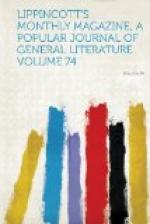W.
SKETCHES OF EASTERN TRAVEL.
III.—BANGKOK.
We left Singapore—which, though an English colony, is a very Babel of languages and nations—in a Bombay merchantman, whose captain was an Arab, the cook Chinese, and the fourteen men who composed the crew belonged to at least half that many different nations, whilst our party in the cabin were English, Scotch, French and American. After eight days of rather stormy weather we disembarked at the mouth of the Meinam River, thirty miles below the city of Bangkok. Owing to the sandbar at the mouth, large vessels must either partially unload outside, or wait for the flood-tide when the moon is full to pass the bar; and to avoid the delay consequent upon either course, we took passage for the city in a native sampan pulled by eight men with long slender oars. The trip was a delightful one, giving us enchanting glimpses of the grand old city long before we reached it. Amid the mass of tropical foliage, gleaming out from among clustering palms and graceful banians, we could discern the gilded spires of gorgeous temples and palaces, of which Bangkok boasts probably not less than two hundred. The temples, with their glittering tiles of green and gold, and graceful turrets and pinnacles from which hang tiny tinkling bells that ring out sweet music with every passing breeze, their tall, slender pagodas and picturesque monasteries, stand all along the banks of the river, its most conspicuous adornments. But pre-eminent, both for height and splendor, is Wat Chang, visible, all but its base, from the very mouth of the river. Its central spire, full three hundred feet in height, towers grandly above the surrounding turrets and pagodas, the white walls gleaming out from the dark foliage of the banian, and the feathery fringes of the palm reflected on its shining roof.
[Illustration: THE KING OF SIAM RETURNING TO HIS PALACE.]
The two main entrances to the royal palace are of white masonry very elaborately adorned. Groups of elegant columns support a capital composed of nine crowns rising one above the other, and terminating in a slender spire of some forty feet. The whole is inlaid in exquisite mosaics of porcelain, the various colors arranged in quaint devices, so as to produce the happiest effect, while the reflection of the sun’s rays upon the glazed tiles, the numberless turrets and pinnacles of the lofty pile, and the porticoes and balconies of pure white marble opening from every window, and leading to delectable conservatories, luxurious baths or fairy groves and arbors, present, as grouped together, a sight worth a trip across the waters to enjoy. The engraving represents one of these entrances, and His Majesty Somdetch Phra Paramendr Maha Mongkut, the late supreme king of Siam, on his return from his usual afternoon promenade. This “promenade,” however, was not a walk, a ride or a drive, but an airing in one of the royal




